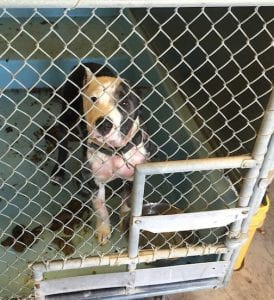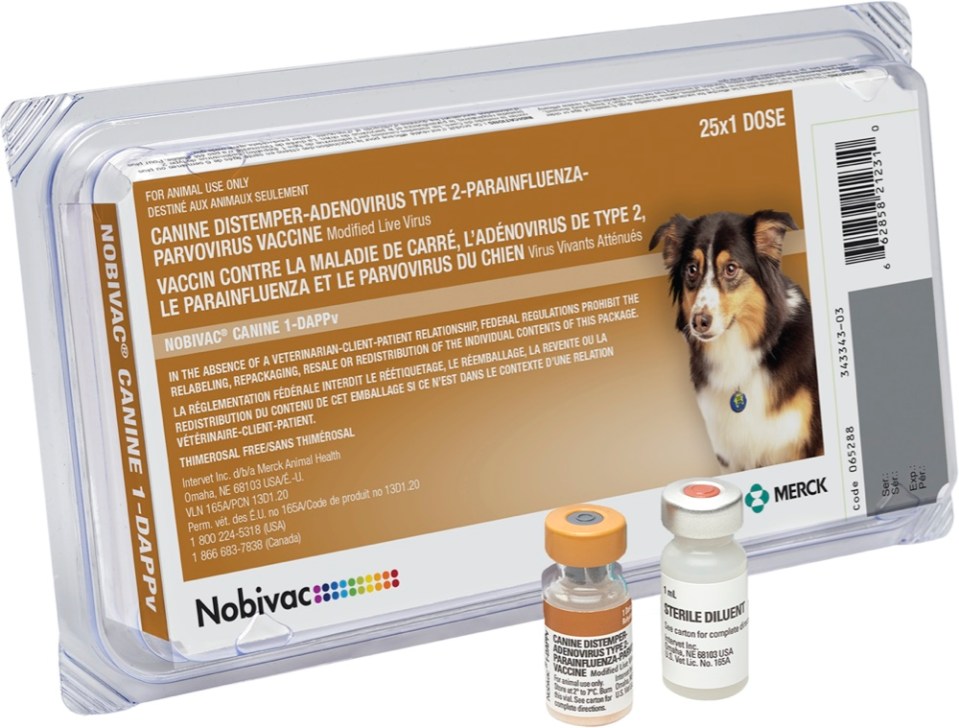This guide should to be used as an informational fact-sheet; shelters should create their own plan and protocol for handling CDV cases and an outbreaks. Having a plan and trained personnel means a response can be started immediately and lives can be saved.
The virus:
Canine distemper virus (CDV) is a highly contagious viral disease of dogs. The distemper virus is closely related to the measles virus in humans, and despite it’s name, infects a variety of animal species including skunks, raccoons, ferrets, and large cats (lions, tigers, leopards, etc.) People cannot get CDV, and domesticated dogs are considered the reservoir host. CDV is found across the globe and is a major concern in areas where large numbers of dogs are unvaccinated and where the virus persists in wildlife.
In shelters and closed populations, CDV infections may be recognized as acute outbreaks with high morbidity and mortality, or in some populations, infections may simmer at low levels, unrecognized until an animal dies. Depending on the individual dog, infections can be sub-clinical, mild, severe, or fatal.
How do dogs become infected?
CDV is transmitted when affected dogs cough and aerosolize viral particles, which are inhaled by dogs sharing the same air space– this could be a shelter room or enclosure, a transport vehicle, or someone’s house. Transmission by contact with urine, feces, and respiratory secretions is also possible. Susceptible dogs are most likely to become infected when they are around groups of other dogs (shelter environments, playgroups, kennels, etc.) Transmission can happen from dogs with clinical signs, or dogs whose signs of disease are not readily noticed.
There is no breed or gender predilection for CDV infection. Risk of infection is highest among puppies and young dogs who did not receive an initial vaccination series, and have contact with large groups of other dogs. Maternally derived antibodies in puppies may provide protection against CDV for 9 to 12 weeks, but these antibodies wane unpredictably.

How long after exposure can a dog get sick?
The incubation period, onset of clinical signs, and severity of CDV are quite variable from dog to dog and depend on several factors. These factors include viral strain, individual dog immunity (age, vaccination status, other illnesses,) and level of exposure (same kennel vs same room or transport vehicle vs passing by on the street.) After exposure, symptoms can be seen in less than one week to up to six weeks later, which makes tracing the source of infection challenging. Because it can take so long for a dog to show symptoms, typical 1-2 week intake quarantines do not guarantee a dog will not become ill with CDV, and generally only serve to increase risk of infection.
What are the symptoms of CDV?
Systemic signs may be absent to mild to severe, and include fever, nasal and ocular discharge, cough, respiratory distress, vomiting and diarrhea. Dogs may develop skin crusting on their noses and feet called hyperkeratosis (“hard pad disease”) and puppies may get skin rashes orswollen lymph nodes. Neurological signs may be seen within 1-3 weeks following recovery from other systemic clinical signs, but may also show up several months (or years) post-infection. Neurological signs include ataxia, seizures, involuntary muscle twitching (“chewing-gum seizures,”) meningitis, or balance problems. Neurological symptoms are most common in puppies but can also be seen in unvaccinated adult dogs.
How is it diagnosed?
Unlike diseases for which we have simple tests, diagnosing CDV requires sending samples to a lab. Clinical signs are very difficult to distinguish from other causes of canine respiratory diseases, so can’t be used to determine an accurate diagnosis. Whenever an unvaccinated dog from a high risk area has an unexplained fever or suggestive clinical signs (respiratory, GI, neurological, etc), or whenever a puppy has neurological symptoms, testing should be performed.
There are multiple testing options, which are used for different reasons. RT-PCR of nasal swabs is the diagnostic tool of choice, whether in a test panel with other respiratory diseases or just CDV alone. This test is highly sensitive & specific, and is quantitative, meaning that the test can tell the veterinarian whether a lot of virus is present, or a tiny amount of virus is present. The amount of virus can be important when distinguishing actual infection from left-over viral particles from vaccination. PCR testing takes several days to get results back; in a suspect dog with ocular discharge, conjunctival swab cytology using dif-quick stain may sometimes show pink inclusion bodies in the cytoplasm of conjunctival epithelial cells and provide a lucky early diagnosis.
Antibody tests can be useful to determine the likelihood that an exposed dog is protected, often performed at the same time as a RT-PCR to rule out infection as the source of antibodies. This test can be especially useful in outbreak situations, allowing PCR negative protected dogs to be “cleared” and adopted out so the shelter can focus on managing their ill and unprotected exposed population. Also called “serology,” antibody tests are available as a bedside well-plate based batch test, or blood can be sent to the laboratory. Rumors are that a new snap test is coming to market that also detects antibodies against distemper. Because it only detects antibodies, serology should not be used as a diagnostic test for CDV.
Post-mortem tests such as necropsy and histopathology may be performed if a dog or puppy dies; samples of the lungs, bladder, and lymph nodes are the recommended tissues for viral detection. Some laboratories offer a “necropsy in a bottle” option, where these tissues can be submitted at a lower price than an entire body. All body tissues should be handled with care because they can be a source of infection for other animals, including wildlife.
How is it treated?
There is no specific treatment for CDV, just as there is no specific treatment for many viral diseases. Aims of treatment include supportive care and reducing the risk of secondary bacterial infections. Even with aggressive therapy, mortality rates range from 10-50%, depending on the dog’s age and severity of infection. In general, animals with neurolgical signs have the worst prognosis, and may continue to test positive for 6 months or longer after initial diagnosis. Often, euthanasia is considered in these cases. Ultimately, treatment for these cases should be based on clinical signs, the shelter’s capacity to provide the intense care required while supporting the health of the rest of the population, the shelter’s ability to keep infected animals isolated, the ability to keep exposed animals in quarantine, the ability to prevent exposure to any other animals, and the individual animal’s welfare.
Can you prevent it?

YES! Vaccination is the most effective way to prevent CDV. It is essential that dogs and puppies are vaccinated in shelters at or before the time of intake with a modified-live (MLV) or recombinant CDV vaccination (given in combination as DHPP/DA2PP). Puppies should be vaccinated starting at 4 weeks of age, and recieve a booster every 2 weeks until the puppies leave the shelter or reach 20 weeks old. For more information about shelter vaccinations, please visit the 2022 Guidelines for Standards of Care in Animal Shelters by the Association of Shelter Veterinarians.
Transmission is most likely to occur via direct contact of infected dogs with susceptible or unvaccinated dogs. Therefore, recognition and isolation of dogs with clinical signs is essential in a shelter environment. Daily rounds and good shelter communication will make sure that clinical signs are noted and managed swiftly. Close attention should be paid to respiratory disease and other typical symptoms of distemper, and risk analysis should include vaccination history and exposure risk history, including shelter transport and geographical origin. Any dog with symptoms of respiratory disease should be isolated from other dogs without these symptoms; once diagnosed, CDV+ should be isolated from those who test negative.
If a dog is diagnosed and removed from a shelter area, other dogs who have been sharing the same airspace should be considered “exposed,” and tested for the virus and protective antibodies. CDV is an enveloped virus, so does not survive well outside of the body; the shelter area should be cleaned thoroughly using the shelter’s routine disinfectant protocol, and can be safely used once sanitized.
Conclusion:
CDV is a problematic disease in shelters. It should be considered in any young dog with an unknown vaccination history from an endemic area that presents with concurrent respiratory disease, diarrhea, skin disease, and especially CNS signs, but can also be present in asymptomatic dogs. Fortunately, the disease is largely vaccination-preventable and sanitation is straightforward. A shelter can significantly reduce the risk of CDV outbreaks through vaccination at or before intake, isolation of animals showing clinical signs, and management practices that carefully weigh dog-to-dog contact and biosecurity.
Communities can help reduce CDV outbreaks by making sure they get their dogs vaccinated, and by community support for low-cost vaccination and canine spay/neuter clinics.
Resources:
- The Guidelines for Standards of Care in Animal Shelters. Association of Shelter Veterinarians, Second edition. (2022). Journal of Shelter Medicine and Community Animal Health.
- Miller, L. (2021). Infectious Disease Management in Animal Shelters. Wiley Blackwell.
- Miller, L., & Zawistowski, S. (2013). Shelter Medicine for Veterinarians and Staff. Wiley Blackwell.
- Polak, K., & Kommedal, A. T. (n.d.). Field Manual for Small Animal Medicine. Wiley Blackwell.
- Canine Distemper https://www.uwsheltermedicine.com/library/resources/canine-distemper-cdv
-
How canine distemper almost ravaged a shelter – and why it didn’t https://sheltermedicine.vetmed.ufl.edu/2019/05/22/distemper-awl/
by Abby Reichard, DVM
Janet L. Swanson Intern
Maddie’s(R) Shelter Medicine Program
Cornell University College of Veterinary Medicine

